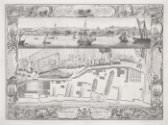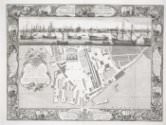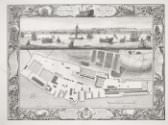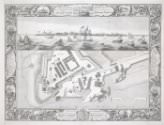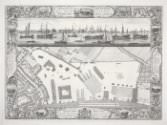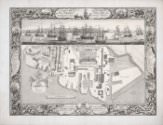A Geometrical Plan, & North Elevation of His Majesty’s Dock-Yard, at Woolwich, with Part of the Town, &c.
A Geometrical Plan, & North Elevation of His Majesty’s Dock-Yard, at Woolwich, with Part of the Town, &c.
One of a series of views of the six Royal Dockyards, which were by the mid-eighteenth century the world's largest industrial complex and the state's biggest investment. These engravings present the dockyards as orderly, efficient, and rational; each makes reference to the specific functions of the dockyard represented, which depended in part on location. Deptford and Woolwich dockyards, close to London on the Thames, were too far from the coast to be useful as naval bases and were used for shipbuilding and storing masts and timber. In the vignettes surrounding the central image in this print, the ship is seen first under construction, then launched, getting its masts in, preparing to sail, under sail, engaging the enemy, taking a prize in tow, undergoing a storm, and wrecked. They suggest a ship’s “biography,” a trope often used as an allegory of human life. The relationship of the vignettes to the central plan and elevation in these prints is implicit: they suggest the trajectory of the ship once it has left the dockyard and the hazards it will face that will require it to return for repairs.
